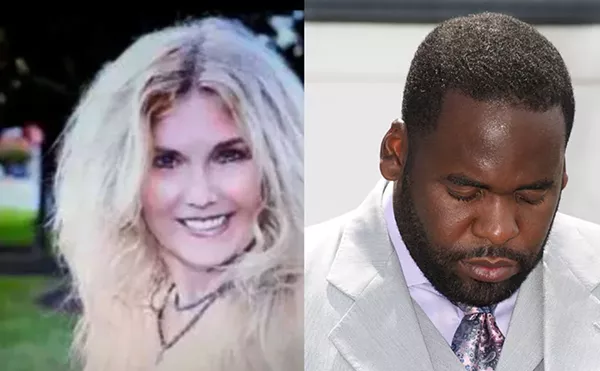
Audio By Carbonatix
[
{
"name": "GPT - Leaderboard - Inline - Content",
"component": "35519556",
"insertPoint": "5th",
"startingPoint": "3",
"requiredCountToDisplay": "3",
"maxInsertions": 100,
"adList": [
{
"adPreset": "LeaderboardInline"
}
]
}
]
Simply perfect and simply impossible. And that's just the title of this newly reissued little book, a work possibly more important now than when first published.
Today, you could no more imagine calling a book Negroes With Guns than one could imagine asking about the president's semen back in 1962 when this book first appeared. That was a time when Northern white America was just beginning to dimly realize that there was a separate, black America where something was starting to happen. And no, Mr. Jones indeed didn't really know what it was. Yet in this case, history has provided a shield from one more reality-avoiding taboo. Far more than in the Kennedy era, the nightmare of every white suburbanite, from Sterling Heights to Southgate, is precisely that: Negroes with guns.
Now comes Robert F. Williams (1925-1996) to testify otherwise, and Gloria House, an associate professor in WSU's College of Lifelong Learning, and Timothy Tyson, who teaches at the University of Wisconsin-Madison, to show in two brilliant introductory pieces that reality is far more complicated than the textbooks.
Williams was a fascinating man who seems, both in this book and in the new introductions to it, rather more human than the saintly and sanitized portraits of Saints Martin and Malcolm, the martyrs of civil rights legends.
Simply put, he stood for what now seems the less-than-astonishing idea that black citizens (the accepted term then was Negro) ought to defend themselves when attacked by whites who wanted to rape, murder or otherwise molest them. That's what African Americans in the small town of Monroe, N.C. (population: 11,000; 25 percent black) did in the late '50s, and the astonishing truth is that it worked pretty well.
That is crucial for anyone seeking to understand this nation. Students now are largely taught -- when they are taught anything about it at all -- a homogenized version of the great years of the movement (roughly 1954-1966) that dovetails with the sanitized collective memory those older like to cherish of those times.
In this version, nonviolence, as preached and practiced by the Rev. Dr. Martin Luther King Jr. and his followers, was almost universally accepted by black leaders as the answer to destroying the bonds of segregation.
Starting with Rosa Parks and the Montgomery bus boycott, proceeding on through sit-ins at lunch counters and ending with the march from Selma to Montgomery, this was the tactic and ethic that won the day in a decade, after a few highly publicized atrocities.
Later, to be sure, Stokely Carmichael (now Kwame Toure) the Black Panthers and other more militant leaders changed course, but that happened, we like to think, after the main battles had been won and the country was convulsing over Vietnam.
Truth is that the movement, like black America itself, was never a monolith.
I always have felt that the role of returning veterans of World War II and Korea has been underestimated in most analyses of the civil rights movement.
Williams, who returned from serving his country in uniform to take up civilian life in the segregated South, was one of those. Soon after he returned, the local Ku Klux Klan, frustrated at having failed to lynch a black prisoner before his execution, decided to take his body from the funeral home and drag it down the streets. But a man who has been trusted with weapons and command is no longer an easily intimidated sharecropper. Quickly, a band of former soldiers, including Williams, assembled, leveled rifles at the KKK caravan, and forced them off without incident.
That may seem a small thing, but it was not. This led to a unique policy in Monroe in which armed blacks successfully defended themselves on a number of occasions, events described in detail here, little noted by most historians.
Ironically, Williams was not by nature a hothead; his nature was to give the system a chance. But his philosophy got him into hot water in 1959 when, as head of the local NAACP, he first argued against violence after a pregnant black woman had been brutalized. "I told them this matter would be handled through the law," he recounts bitterly. Instead, the accused white man was acquitted in minutes.
Frustrated, an angry Williams said it was time to "meet violence with violence," adding "it is clear there is no court protection of Negroes' rights here, and Negroes have to defend themselves on the spot when they are attacked by whites."
That touched off an outcry that resulted in both white racists and the civil rights "mainstream" distorting Williams' views and making him a pariah and scapegoat for their own ends. To whites, Williams became the specter of their deepest nightmares, an armed, violent black, seeking retribution. To King, he was a useful foil; better help me, the unspoken message was, or this is the future.
Read out of the NAACP within hours, Williams fled, first to Canada, then Cuba (where this book was written) and finally China. Then the old warrior shrewdly did a deal with Richard Nixon's men when they were preparing to renew ties with Beijing.
Williams traded his considerable knowledge of China for safe passage home in 1969.
He then lived out his life in the town of Baldwin, Michigan, after a stint at the University of Michigan's Center for Chinese Studies, dying less than two years ago.
Why does his book matter now?
Because the struggle goes on. Williams really wrote this book not for blacks, but "to clearly reflect the image of evil that is inherent in a racist society so that white Americans will be able to honestly and fully see themselves as they really are." Negroes With Guns is also worthwhile reading as a reminder of how appalling conditions were in this nation less than four decades ago.
More important, it shows how creative and varied African-American responses to them were. And how things are always more complicated than we believe. "When the Negro uses force in self-defense, he does not forfeit support -- he may even win it, by the courage and self-respect it reflects," a black leader wrote in 1959. Those are not, however, Robert Williams' words.
They are those of Martin Luther King Jr.





